Summary
As a broiler breeding company, Aviagen offers advice on the best way to store hatching eggs between
oviposition and the start of incubation. Ideally, all eggs should be set while still fresh – within a week
of being laid. If longer storage is unavoidable, then storage temperatures should be reduced, and
any temperature fluctuations avoided. The advice is safe, and offers minimal opportunities for misunderstanding. In contrast, when hens lay and incubate their own eggs, the eggs laid first will be rewarmed every time the hen returns to the nest to lay another egg. A series of experiments and field
tests looking at short periods of incubation during egg storage (SPIDES) have shown that it is possible
to recover 60-70% of the hatchability lost when storage has to be prolonged for more than a week. The
technique is potentially of value to broiler grand-parent, layer parent and turkey breeder programmes
where order patterns may be uneven, and egg storage unavoidable.

Introduction
Changes during egg storageDuring the day it takes for the egg to form in the oviduct, the embryo will be held at body temperature, and normal embryonic development will occur. When the egg is laid, the embryo will contain over 30,000 cells, and will have reached Stage IIX-X of development. Once the eggs are cooled for storage, embryo development will usually stop, provided the eggs are stored below 24 °C (Eyal-Giladi and Kochav 1976). If the eggs are stored for more than a few days, then embryo cells start to die. After 10-12 days of storage, more than half of the cells present at oviposition will have died (Bakst et al. 2012; Fig. 1).
Figure 1: Embryo cell numbers in broiler breeder eggs change with egg age
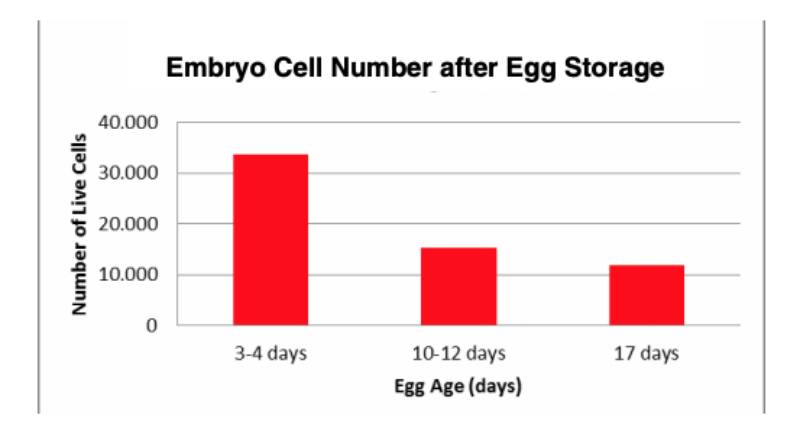
As well as changes in the embryo, the egg contents change as the egg gets older. The albumen becomes thinner and lysozyme activity drops. The yolk membranes become much weaker, and will tend to rupture if placed under any stress. All of these changes will tend to increase embryo mortality. As egg age increases, hatchability usually rises slightly after two days of storage, and then starts to fall again around 7 days, as shown for Ross 308 eggs in Figure 2.
Figure 2: Changes in hatchability over 21 days in Ross 308 parent stock eggs.
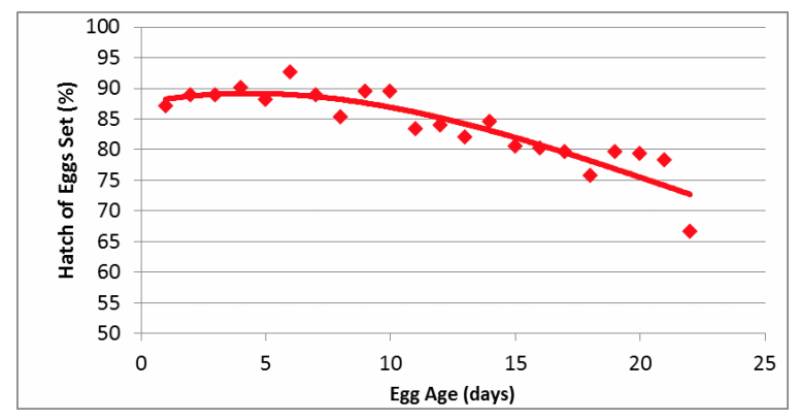
Most of the embryo mortality happens very early in embryonic growth – at the membrane stage of development. In a commercial hatchery this will usually be seen as a higher percentage of candled clears. The chicks that do hatch will need a longer incubation period, because the embryo will have had to grow from the reduced number of live cells at the end of storage. If incubation time is not adjusted, otherwise viable chicks may be lost because they are not yet dry, or are still going through the hatching process. The amount of hatch loss will be variable, depending on how well-controlled egg store temperatures are, and whether there are existing quality issues in the eggs which make them more fragile.
Heat Treatment Before or During Egg Storage
Heating hatching eggs to incubation temperature before storage is not a new idea. Allowing embryo development to continue a little longer after the egg is laid, so that the embryo reaches a slightly later stage of development is known to improve embryo survival after longer storage. At the University of Alberta, Fasenko et al. (2001) showed that giving eggs a single 6 hour period of incubation before the start of egg storage improved the hatch of 14 day stored eggs compared to untreated controls.Eggs vary in their developmental stage when they are laid, but most of them will be at stages IIX-X, just before the formation of the hypoblast. Fasenko and her co-workers suggested that eggs cope better with long egg storage if the formation of the hypoblast is complete but the embryo has not progressed to the stage called the primitive streak.
An alternative hypothesis was proposed by Meir and Ar (1998). They suggested that giving the eggs a short (less than 6 hours) period of incubation at regular intervals during long storage would allow the embryo to carry out cell repair and so reduce the rate of cell death.
Heating eggs to incubation temperatures immediately before cooling them for storage can be difficult to achieve within a commercial farming operation. Most companies transport eggs from the farm to the hatchery twice a week, so eggs are between 1 and 4 days old when they reach the hatchery. For an incubation treatment to be given on the day of lay, either the eggs need to be taken to the hatchery every day, or there needs to be an incubator on every farm. It would not be an easy process to manage. For this reason, our work has focused on incubation during the storage period, which can be imposed at a single location (the hatchery) which is already equipped with suitable equipment.
Experiments
Four replicated experiments were carried out between July 2010 and June 2011.The first three experiments were carried out at the Aviagen Product Development Unit at Albertville in Alabama, using Ross 308 broiler hatching eggs from a commercial parent flocks at peak hatchability.
Each experiment used eggs from a single flock laid on one day. The fourth experiment was carried out in the UK, in the Aviagen PS hatchery, using Arbor Acre female line eggs.
In the first three experiments, the eggs were held in setter trays on a wheeled buggy, which was moved to the corridor of a Chickmaster fixed-rack multi-stage incubator for each heat treatment.
Storage in between treatments was in a controlled environment egg store set at 15.5-18.3°C. A total of 1944 eggs were allocated to each treatment in every experiment, spread over 12 replicate trays of 162 eggs. In each of the experiments there was a positive control, where the eggs were set fresh (3 days old) and a negative control where the eggs were stored without heat treatment for 21 days.
For the final experiment, eggs were heated in setter trays in small Bristol single stage machines, again being restored to the cooled eggs store (17-18°C) between treatments. Eggs were laid by a single small flock over several days, with eggs from each day’s production evenly distributed across the treatments; there were 2520 eggs set per treatment, in replicate trays of 132 eggs.
The experiments explored different variables as follows:
Experiment 1 – How many heat treatments were needed to give the best hatchability? Experiment 2 – What benefit to hatch could be seen in eggs stored for 7, 14 or 21 days? Experiment 3 – What was the best combination of treatment duration and treatment frequency? Experiment 4 – Is the speed at which eggs are heated important?
Experiment 1
TreatmentsIn this experiment, all eggs were stored for 21 days except for the positive control. The eggs were held in the setter corridor for 4 hours for each heat treatment, with 3, 4 or 5 repetitions as follows:
• Treatment 1 – Positive control – eggs set when 3 days old
• Treatment 2 – Negative control – eggs set when 21 days old
• Treatment 3 – Eggs placed in setter corridor for 4 hours on days 8 and 15 of storage. Set on day 21
• Treatment 4 – Eggs placed in setter corridor for 4 hours on days 5, 10, 15 and 18 of storage. Set on day 21
• Treatment 5 – Eggs placed in setter corridor for 4 hours on days 3, 8, 12, 15 and 19 of storage. Set on day 21.
Results
The results from Experiment 1 are shown in Figure 3.
Comments
Although the positive control eggs hatched very well (94.5% hatch of eggs set), hatchability was particularly poor after 21 days storage. This was probably due to suboptimal egg storage conditions during exceptionally hot summer weather. All of the SPIDES treatments improved hatch of stored eggs. It was noticeable that both early dead embryos and late dead embryos and live pips were much reduced by SPIDES treatment; hatchery staff also commented that the treated eggs showed much less hatch delay than the untreated ones after the 21 days storage. Applying four treatments gave better results than applying three or five treatments, the difference was statistically significant (P<0.001).
Figure 3: Early and late embryo mortality and hatch of eggs set in Experiment 1
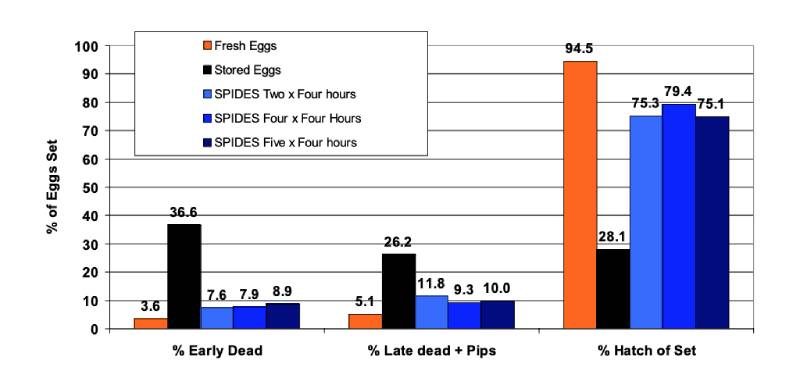
Treatments In this experiment we wanted to confirm the results of the first experiment during cooler weather, and also to look at how long storage needed to be for there to be a benefit from SPIDES treatment
• Treatment 1 – Positive control – eggs set when 3 days old
• Treatment 2 – Negative control 1 – eggs set when 7 days old
• Treatment 3 – Eggs placed in setter corridor for 4 hours on days 4 of storage. Set on day 7
• Treatment 4 – Negative control 2 – eggs set when 14 days old
• Treatment 5 – Eggs placed in setter corridor for 4 hours on days 4, 7 and 11 of storage. Set on day 14
• Treatment 6 – Negative control 3 – eggs set when 21 days old
• Treatment 7 – Eggs placed in setter corridor for 4 hours on days 5, 10, 15 and 19 of storage. Set on day 21.
Results Internal Egg Temperatures
Temperature sensors placed in sample eggs showed that the eggs heated faster at the top of the buggy, nearest the roof-mounted fan, and slowest in the middle of the buggy, which was shielded from air movement by surrounding trays of eggs (Figure 4). It is noticeable that the four hour exposure was not long enough to lift the temperature in the middle trays to incubation temperature. However, inspection of the individual replicate (tray) results showed that the treatment was equally effective in all positions.
Hatchability and Embryo Mortality Patterns
The eggs in this experiment hatched in December, and the hatch loss after 21 days was much closer to normal levels than in Experiment 1. As shown in Figure 5, SPIDES treatment improved hatch at all three egg ages.
Even after only 7 days, where the hatch drop was numerically small, the improvement was statistically significant (P< 0.05).
Figure 4: Internal egg temperatures measured at 3 locations on the egg store trolley during
the application of 4 hours of SPIDES treatment.
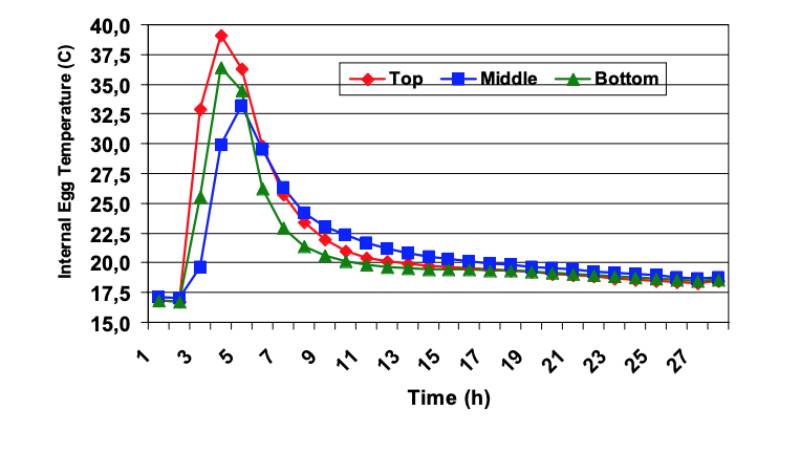
Figure 5: Early and late embryo mortality and hatch of eggs set in Experiment 2
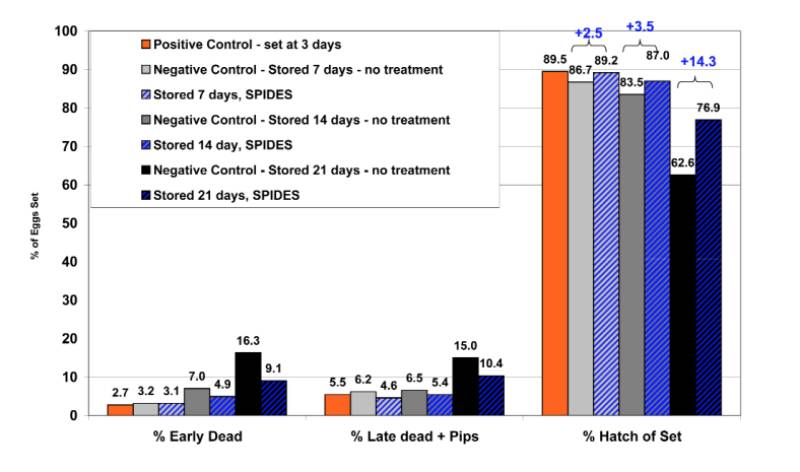
Experiment 3
Treatments • Treatment 1 (positive control) – eggs set when 3 days old• Treatment 2 (negative control) – eggs set when 21 days old without any storage treatment
• Treatments 3-11 – eggs stored 21 days, during which time they were treated 3, 4 or 6 times for either 2, 4 or 6 hours.
Exact timings of heat treatment are given in the table below:
 Exact treatment days were adjusted to avoid overloading the setter on any one day, while still having
roughly even intervals between each treatment.
Exact treatment days were adjusted to avoid overloading the setter on any one day, while still having
roughly even intervals between each treatment.
Results Internal Egg Temperatures
Figure 6: Average Internal egg temperatures during SPIDES treatments of different duration
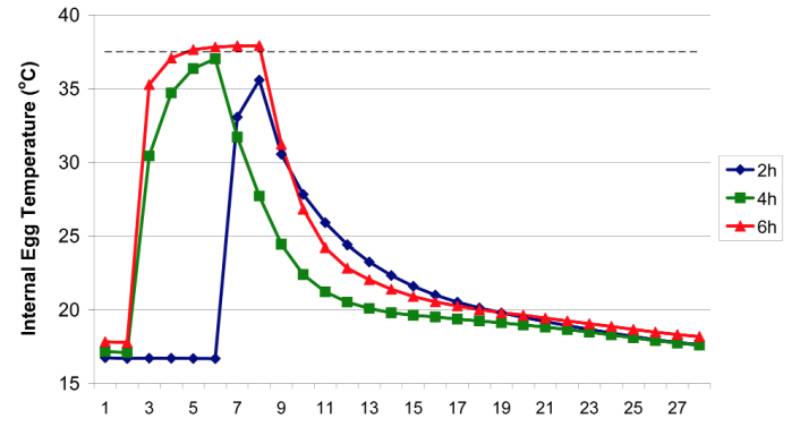 Figure 6 shows the average of top, middle and bottom trays for each treatment duration. It can be
seen that after 6 hours exposure, the eggs had received 4 hours at incubation temperature, while
after 2 hours they only reached an average of 35°C. Temperature range between top, middle and
bottom trays was greatest for the 2 hour treatment, and least for the 6 hour
Figure 6 shows the average of top, middle and bottom trays for each treatment duration. It can be
seen that after 6 hours exposure, the eggs had received 4 hours at incubation temperature, while
after 2 hours they only reached an average of 35°C. Temperature range between top, middle and
bottom trays was greatest for the 2 hour treatment, and least for the 6 hour
Hatchability and Embryo Mortality Patterns
Figure 7: Hatch of eggs set in Experiment 3
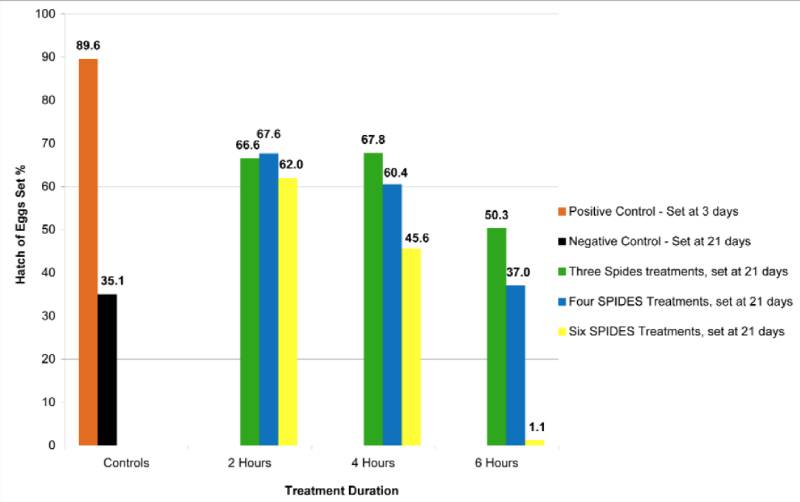
It can be seen that the shorter exposure times gave the best results, despite reaching a lower and more variable temperature. As shown in Figure 7, six repetitions of a six hour treatment caused almost complete hatch failure.
It was not possible to break open un-hatched eggs in this experiment, but Figure 8 shows the candling figures, – candled clears include both infertile and early dead embryos. Six hour treatments gave more clears than 2 or 4 hour treatments. Embryo survival in eggs given four repetitions of six hours was no better than in stored untreated eggs, while six repetitions of six hours caused nearly all the embryos to die early in incubation, showing 97% of the eggs clear at candling.
Figure 8. Candled Clears Experiment 3 (includes infertile and early dead embryos)
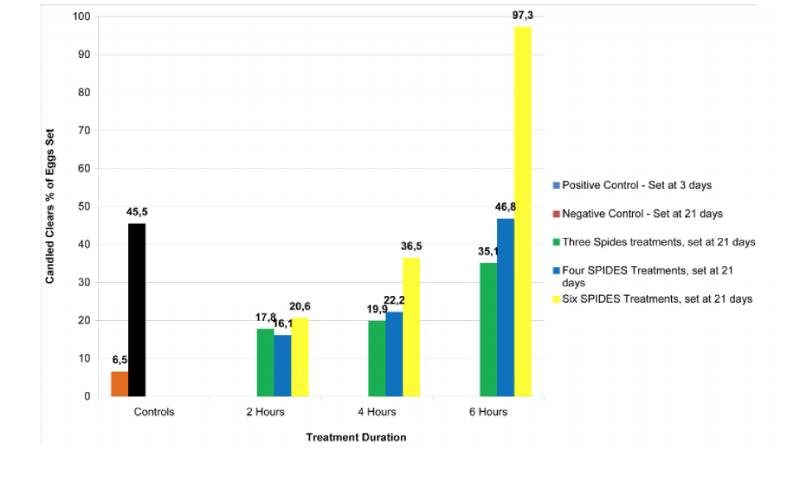
The temperature traces were re-examined to investigate how long the egg contents remained above 32°C. The observed hatch lift relative to the negative control is plotted against the exposure time in Figure 9.
Figure 9: Percentage recovery in hatchability after SPIDES vs cumulative time above 32°C
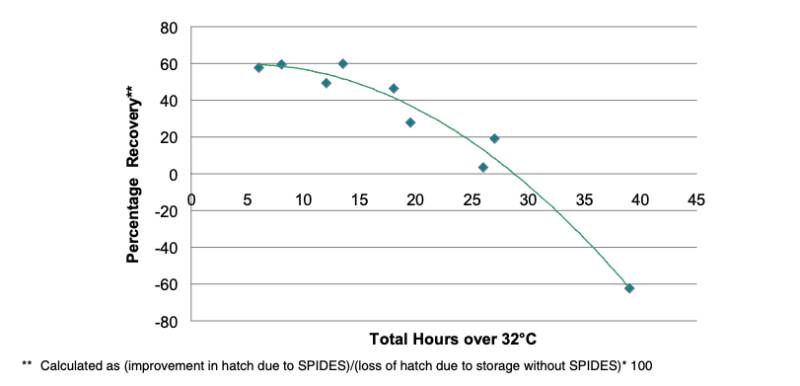
This relationship suggests that the eggs should be limited to no more than 15 hours above 32°C for optimal results, so cooling time after treatment is also important. The three experiments had shown that SPIDES can give a significant improvement in hatchability in eggs stored for 7 days or longer. With prolonged storage, repeated treatments were needed, but long exposure times gave poor results.
Experiment 4
Experiment 4 was carried out in a commercial parent stock hatchery in the UK, using Arbor Acres female line eggs from a relatively young (28 weeks) flock. It was a small population, and in order to accumulate sufficient eggs for the experiment, eggs were saved over several days’ production. We were aware that the speed at which the eggs were warmed up in the Chickmaster machines in the first three experiments was considerably faster than we would be able to achieve in a fully-loaded single stage machine, which would be the norm for commercial implementation. Experiment 4 was set up to compare rapid warming (up to incubation temperature in 4 hours) with the norm for the hatchery, where eggs take 8 hours to reach incubation temperature.For logistical reasons, the eggs were 8 days old when they reached the hatchery, so the positive control was set immediately on arrival. The rest of the eggs were stored until they were on average 24 days old, receiving fast or slow SPIDES treatments 4 times during the storage period.
• Treatment 1 (positive control) – eggs set when 7 or 8 days old
• Treatment 2 (negative control) – eggs set when 22, 23, 24 or 25 days old
• Treatment 3 (fast SPIDES) – eggs heated so that they reached incubation temperature in 4 hours, set when 22, 23, 24 or 25 days old.
• Treatment 4 (slow SPIDES) – eggs heated so that they reached incubation temperature in 8 hours, set when 22, 23, 24 or 25 days old.
In both SPIDES treatments, the eggs were returned to the cooled egg store immediately after they reached incubation temperature
Results
Internal Egg TemperaturesFigure 10: Egg Shell temperature of eggs heated fast or slowly in Experiment 4

Good treatment separation was achieved, and both treatments reached incubation temperature.
Hatchability and Embryo Mortality Patterns
Figure 11: Hatchability Experiment 4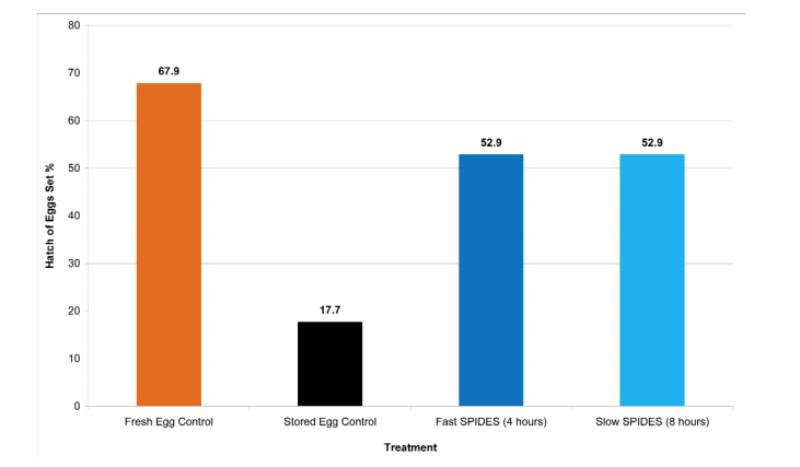
This experiment showed that heating the eggs over 8 hours worked just as well as heating them to the same temperature over 4 hours. So a single-stage setter can be used to give the SPIDES treatments. It also showed that SPIDES treatment improved hatch in eggs laid by high-generation pure line stock – all previous experiments had used Ross 308 broiler hatching eggs.
Field Trials
Having shown in small-scale experiments that SPIDES could be made to work, we asked the Aviagen hatchery managers around the world to test it in their own hatcheries. Trials were run in New Zealand, the UK, the USA, Turkey, Hungary, Russia, India and Sweden – a total of 17 trials and 57 comparisons over the full range of Aviagen broiler pure lines and crosses.It soon became apparent that it was not helpful to talk in terms of exposure time – different machines take more or less time to reach incubation temperature, which will be further modified by how fully they are loaded. We also found that provision to cool the eggs made a big difference, and here the big single stage incubators were a big help, because many of them had a pre-warm programme designed to take the eggs up to 26°C, which was equally useful in cooling them down again.
Taking the results of all the trials where temperature management had been within the desirable range, we found that the average improvement after SPIDES treatment followed a very similar pattern to that shown in Experiment 2.
Figure 12: Average improvement in hatchability after SPIDES treatment vs. egg age. Average
of 34 paired comparisons, various Aviagen lines and crosses
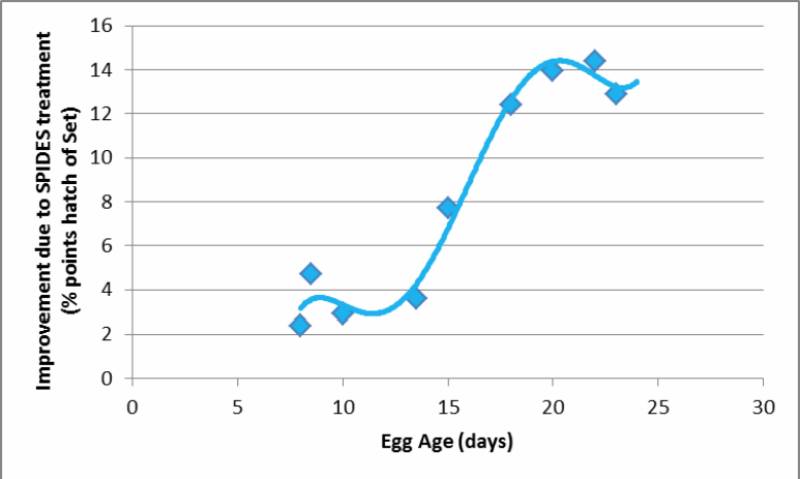
Commercial Layers and Turkeys
Having shown in Experiments 1&2 that SPIDES could be made to work, the results were shared with sister companies within the EW Group producing commercial layer stock, vaccine eggs and turkeys.Trials with layer breeders have given very similar results to those seen with the broiler breeder lines.
The turkey hatcheries have also seen good results, although the optimal treatments seem to be slightly different in detail. Turkey embryos are less developed when the eggs are laid, which probably explains most of the differences seen.
Conclusions
The best practice for storing broiler hatching eggs is still to set the eggs within a week of being laid. However, if longer storage is unavoidable, hatchability can be maximised by using appropriate SPIDES treatments during storage. For the best results, the eggs should be treated before hatch starts to fall, with repeat treatments every 6-7 days. While the heating speed and final temperature are both very forgiving, even cooling after treatment will help to maximise the impact. Warming the eggs too often, or for too long will limit the value of using SPIDES, and cumulative time above 32°C should not exceed 15 hours. SPIDES treatment is of potential benefit to broiler and commercial layer breeds, and to turkeys.References
Bakst, M.R., Akuffo, V., Nicholson, D. and French, N. (2012) Comparison of blastoderm traits from 2 lines of broilers before and after egg storage and incubation. Poult Sci 91:2645-2648.Eyal-Giladi, H. and Kochav, S. (1976) From cleavage to primitive streak formation: A complementary normal table and a new look at the first stages of the development of the chick: I. General morphology. Developmental Biology 49:321-337.
Fasenko, G. M., Robinson, F. E., Whelan, A. I., Kremeniuk, K. M. and Walker, J. A. (2001) Prestorage Incubation of LongTerm Stored Broiler Breeder Eggs: 1. Effects on Hatchability. Poult Sci 80:1406-1411.
Meir, M. and Ar, A. (1998) Pre-incubation warming as a means of lengthening storage time of fertile eggs Proc. 10th European Poultry Conference, Israel, 1998:825-829.
Zusammenfassung
SPIDES: Kurzzeiterwärmung von Bruteiern während der Lagerung
Als Basiszüchter von Broilern bietet die Firma Aviagen u.a. Brütereien Empfehlungen für die optimale Lagerung von Bruteiern vom Legetag bis zur Einlage. Im Idealfall sollten alle Eier frisch, d.h. innerhalb einer Woche nach der Eiablage, eingelegt werden. Die übliche Empfehlung für längere Lagerung ist, die Lagertemperatur abzusenken und Temperaturschwankungen zu vermeiden. Wenn aber Hennen ein Gelege im eigenen Nest sammeln, wärmen sie alle bisher gelegten Eier jedes Mal kurz auf, wenn sie das Nest aufsuchen, um das nächste Ei zu legen. In einer Serie von gezielten Versuchen und Feldtests konnten wir nachweisen, dass kurzzeitige Erwärmung von Bruteiern bei mehr als einwöchiger Lagerung helfen kann, 60-70% der Schlupfminderung zu vermeiden. Die Technik bietet sich für Großelterntiere und Elterntiere von Broilern, Legehennen und Puten an, bei denen schwankende Liefertermine und Herdengrößen im Aufzuchtbetrieb häufig eine längere Bruteilagerung erfordern.
اشترك في نشرتنا الإخبارية
وتعرّف على آخر أخبار الصناعة.







